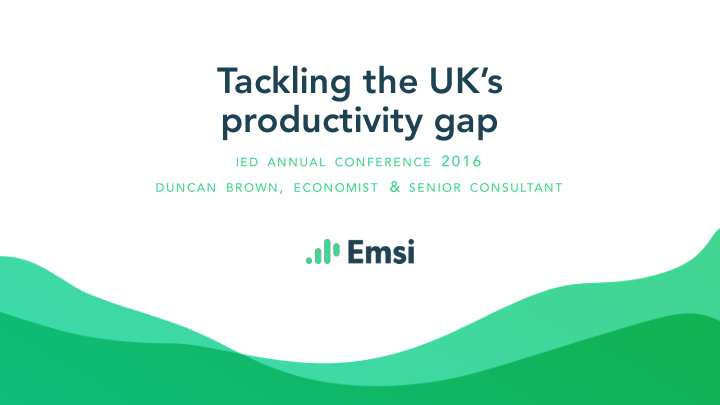



Tackling the UK’s productivity gap IED ANNUAL CONFERENCE 2016 BROWN , ECONOMIST & SENIOR CONSULTANT DUNCAN
Productivity The value of the stuff we make What it takes to make it
What have we learned about productivity? 1. Not manna from heaven – 2 per cent, reliably, every year 2. Happens from real innovations in real workplaces 3. Distribution matters – averages can obscure as well as inform 4. Spillovers matter – a little success can go a long way
Every place has its own story 80 Employment rate, %, 2004 to 2014 75 70 65 15,000 20,000 25,000 30,000 35,000 40,000 GVA per head, £2014, 2004 to 2014 Source: ONS GVA for LEPs: 1997 to 2014 (deflated by GDP deflator) and Nomis/ONS APS employment rates for 16-64s by LEP , Q4 in each year.
And averages really can mislead; just one LEP area contains these areas 85 Employment rate, %, 2004 to 2014 80 75 70 65 15,000 20,000 25,000 30,000 35,000 40,000 Average earnings (mean), £2014, 2004 to 2014 Source: Nomis/ONS APS and ASHE analysis.
Productivity differences reflect job differences 2003 2016 Employment share of occupational group 100% 75% High 50% Middle Service Labour 25% 0% Place A Place B Place A Place B Source: Emsi 2016.1 occupations.
Source: Emsi 2016.1 occupations, top 5 specified by shift in Location Quotient from 2016 to 2022. magnify those differences Projected job specialisations will Median earnings, £ 2015 10,000 20,000 30,000 40,000 0 Market research interviewers Window cleaners Footwear and leather working trades Food, drink and tobacco process operatives Area Refuse and salvage occupations Place A Textiles, garments and related trades Place B n.e.c. Road construction operatives Biological scientists and biochemists Chemical scientists Natural and social science professionals n.e.c.
Beware the cliché! Different skills matter in different places. STEM skills and creative skills are always good, but their value will vary locally. Getting the right mix of skills matters – and that needs detailed local intelligence.
Breaking through the limits of today’s data for economic development § Play to your strengths … but not always so clear to understand where those strengths lie – how to look beyond SIC codes? § Make the right comparisons ... but neighbouring local authorities aren’t always peers, so where to look? § Attract a talented workforce ... but what’s the right mix between a ‘place to live’ and a ’place to work’? § Getting more granular … what beyond ’technical skills’ are employers looking for? What can your workforce offer?
Thank You Duncan Brown duncan.brown@economicmodelling.co.uk economicmodelling.co.uk
Recommend
More recommend